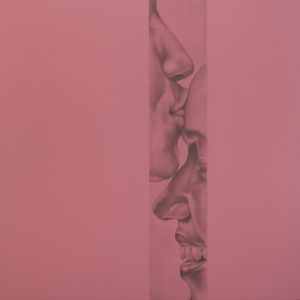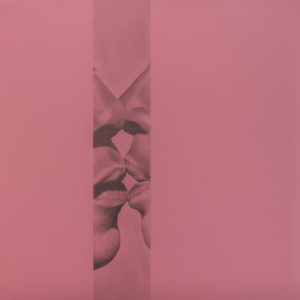“There are far more similarities to human touch than there are differences, regardless of who you love,” says artist Cameron Barker. “Because of the need many people feel to reject certain kinds of loving, consenting touch comes from a place of fear.”
A 2020 M.F.A. graduate and postgraduate fellow at Tufts University, Barker is one of 12 artists introduced this year by Room 68, an art and design gallery at 377 Commercial St. in Provincetown. His “Glorious” series, a collection of hyper-realistic drawings celebrating queer intimacy, is on view through New Year’s.
“Each year, I try to include a few recent graduates studying art or design in the New England area,” says owner Brent Refsland. “Cameron’s ‘Glorious’ series exemplifies the talent, cohesive ideas, and skill of his studio practice.”
The 11 pieces in the series reference “glory holes” — openings cut into public bathroom walls or slits between cubicles where anonymous sexual encounters would happen between men because such relations were forbidden or suppressed. After the HIV epidemic obliterated many of the rules and conventions of queer sex, glory holes largely disappeared, yet they remain a theme in gay pornography and fantasy.
Barker’s drawings challenge the sleazy connotations, both past and present, of glory hole sex and voyeurism by depicting glimpses of exquisitely tender erotic moments: the longing of open lips, fingers playfully interlacing, a light kiss on a forehead, faces touching.
“My intention in this work is to show the history of forced secretness and, at the same time, circumvent it by demonstrating the unifying aspects of a loving connection,” Barker says. “ ‘Closeness’ and ‘intimacy’ are buzzwords that get thrown about, but, for me, the concept is very serious. I think that is why I love Provincetown so much, because I am able to hold the person’s hand that I love and lean up against them and not feel in danger.”
Instead of drawing live models, Barker worked in this series from stock images used in advertisements for HIV medication and photographs of queer brutalization on the internet.

“Public display of affection as queer people comes with some danger,” he says. “I came to realize that every photo I came across on the internet was some news story reporting on a hate crime or some sort of brutality because a couple was holding hands. I wanted to decontextualize this pairing of queer touch with brutality and show the intimacy in these images as simply human,” he says.
Barker honed his intricate, hyper-realistic style during an intensive three-month drawing program at Old Hollows Atelier in the Colorado Rockies, where he studied the Old Master drawings of Charles Bargue. “I take great pride in using the French l’école drawing techniques to portray human experiences that had been previously demonized,” he says. “I now get great joy out of using this knowledge to draw closeness, love, and, perhaps, the occasional hyper-realistic penis.”
The pink backgrounds in Barker’s “Glorious” series also have a backstory. “I work with ground marble dust, which is, technically, a pastel. It has a really lovely touch to it. The color pink was a symbol of survival during the 1980s AIDS crisis,” Barker says, referencing the “Silence=Death” logo adopted by ACT UP, which depicts the pink triangle used by Nazis to identify homosexuals in concentration camps. “The soft shade of the material just feels sweet and visceral. It also makes me think of the color I see through my eyelids when I close my eyes.”
Barker links his interest in exploring intimacy in his art to his childhood. He was raised in Longmont, Colo., a conservative community outside of liberal Boulder.
“My earliest memories are of drawing with my mom. Growing up, it was our way of being together,” he says. Although his parents were “the pinnacle of what every gay person should have as parents,” Barker internalized a great deal of homophobia in Longmont. “I grew up in a place where queerness was not necessarily a safe thing. I never saw men kissing men on TV, or women kissing women, and I didn’t know what transgender meant until I was probably 20, which is astonishing,” he says. “It became a matter of survival to reject a part of who I was so that I could fit into hetero-normalcy.”
The themes of hiddenness and visibility in Barker’s drawings are a nod to his own liberation from self-imposed constraints and his subsequent ability to openly express and find joy in the physical closeness he holds dear.
“These pieces represent a celebration of touch, but also an acknowledgment of having to hide,” Barker says. “For me, these gaps represent a more open society, one where we can continue to see the false notion that a person’s race, sexuality, or gender can be right or wrong. It’s enough.”






